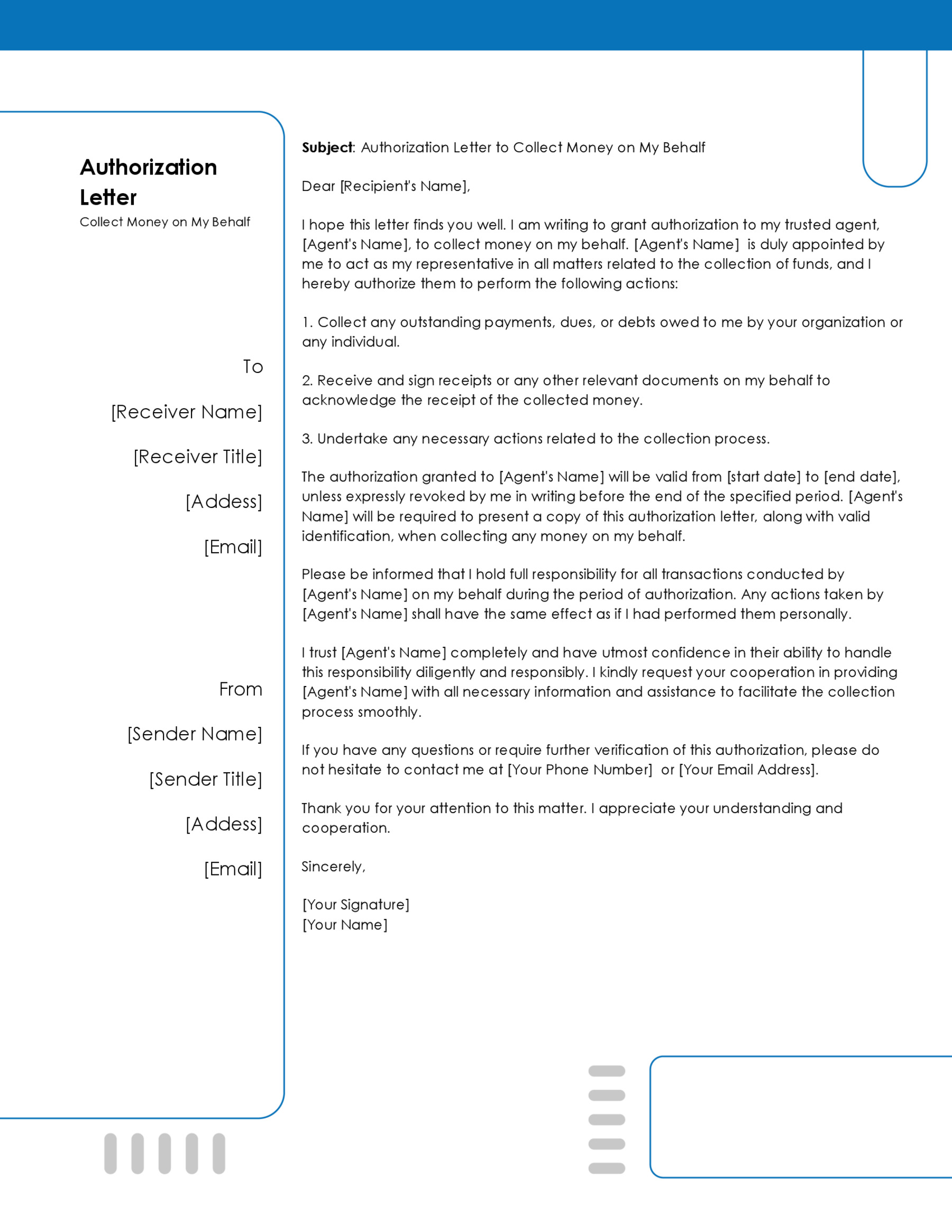Hiring managers commonly use cover letters to evaluate a job applicant’s credentials and potential. By highlighting skills closely matched to the demands of the position, you show how valuable you would be to the company in your letter. When paired with your resume, a solid letter increases your chance of getting interviewed for an employment opportunity.
An employment cover letter is a document that goes with your CV and states why you are submitting a job application for that particular position.
It describes how you meet the firm’s requirements and why you are the ideal candidate. It also introduces you to the potential employer and explains what you can offer the company. While a cover letter builds a connection between your resume and the position you’re applying for, a resume only showcases your education and employment background. Although these letters are often optional, most businesses make them mandatory when posting jobs.
If you’re trying to apply for a job that requires a cover letter, you’re at the right place. This post teaches you how to write a letter that sets you apart from the competition by:
- Showing you the art of writing a standout cover letter from scratch.
- Showing you how to connect your resume and cover letter to help you get more interviews.
- Giving access to tips and good cover letter samples can boost your chances of being hired.
Picking the Correct Cover Letter Template
The first impression you create while writing a cover letter for employment is crucial. You need a professional-looking paper in addition to the proper wording if you want employers to take notice of you. You may build a letter that will wow employers using the free, expertly-designed templates of cover letters offered on this website. There is something here for everyone, regardless of their level of experience.
To assure quality, all templates have been tested by professionals in the area. By using them, you may;
- Spend less time and stress.
- Use appropriate fonts and formatting.
- Design a cover letter that distinguishes itself from its competitors.
- You may convince potential employers that you are a professional and dedicated to the job.
What to Include in a Winning Cover Letter?
Hiring managers often use these letters as a deciding factor in their choice. You should therefore ensure your cover letter is in excellent shape, showcasing why you should be hired ahead of other job seekers. To achieve this, some elements must be present in your letter.
The following are components of a winning cover letter:
Your letter of employment must have a formal header containing your contact information. The following information must be provided in this section:
- Your legal name and don’t use an alias or nickname
- Your email address. Use a professional email account containing your first and last name. Use of email addresses like “jamesdagangsta@gmail.com” might ruin your employment chances
- Your telephone number
- Your city and state are enough; your full residential address is not required in most cases.
- Date of writing the cover letter
- Name of the recruitment manager. If you don’t know the recipient’s name, send your letter to the relevant department at the business or organization (e.g., office manager or executive assistant). Avoid writing “To Whom It May Concern” in your letter, and you should also avoid a phrase like “Dear Sir or Madam.”
- You can also include your profile on a networking site like LinkedIn or GitHub. A link to your portfolio or website might also strengthen your application.
EXAMPLE
A poor header is like:
Allan Stone,
332 St. NE, High River, Alberta, Canada.
In addition to seeming amateurish, this header lacks all the information a potential employer would need or find relevant.
EXAMPLE
A properly written header should look like this:
Allan Stone
Social Media Advertiser
(403) 652-1443
allan.stone@gmail.com
Alberta, Canada
allan.stoneconsultancy.com
24 August 2022
Davis Johnson,
The Hiring Manager,
Green Optimal Workplace Inc.,
Canada.
Respectful salutation
Once you have included all relevant contact information, you may begin composing the cover letter’s body. The person in charge of hiring new staff should always be addressed in the letter. Rather than “Dear Sir or Madam”, you should address it to the recruiting manager!
You want to demonstrate to your future employer that you have done your research on the business and that you are eager to join the team. Nobody wants to receive an application from someone who has sent several applications without carefully examining their intended addressees.
If you don’t know the hiring manager, here are a few techniques to accomplish this:
A LinkedIn search is the right place to start when looking for a contact person’s name and job title. For example; let’s say you’re requesting a position as a communication specialist. Most likely, the director of communications or the chief communications officer should get your letter. Again, you can find this on LinkedIn.
Similarly, when applying to work as a bartender at a restaurant, you would be looking for the “restaurant manager.” There is also a reasonable probability that you will locate the appropriate person under the “Team” part of the organization’s website, which is another approach to finding their name. If you’re still having difficulties finding it, call the business and ask for this information.
EXAMPLE
A bad salutation is:
Dear Sir/Madam
It can set you off on the wrong foot. You do not want to send a message that the receiver is unimportant.
EXAMPLE
You can’t go wrong with something like this:
Dear Dr. Johnson,
Attention-grabbing introduction
Make a strong initial impression in your cover letter if you want to stand out from the competition among job seekers. Of course, it’s doubtful that recruiters would read every letter in its entirety since they typically receive hundreds of applications for each post. Nevertheless, you must engage them from the start if you want your letter to stand out from the competition.
EXAMPLE
Take the following passage is a weak introduction:
I’m David, and I’d like to talk to you about the project manager job at Digirep. My prior work as a project manager at ABC Inc. has equipped me with the abilities and knowledge required for the position.
The above introduction is not particularly useful. It says nothing about your abilities, background, or any other credentials you could have to provide. All the applicants you are competing with have experience in a similar or similar sector.
Instead, accentuate significant achievements that make you a solid contender for the job in your cover letter for employment. The successes must be connected to the position so that the recruiting manager is immediately intrigued.
Now let’s have a look at a compelling introduction.
EXAMPLE
Hello, Dr. Johnson:
Pete is my name. I’ve been paying careful attention to your company’s attempts to improve its project management capabilities, and I’ve looked into the talent it’s looking for. I’ve worked as a project manager for Company M for over three years, and during that time, I’ve closed five deals with Fortune 500 companies. Therefore, I feel I am qualified for the post you are advertising due to my past industry experience and excellent project management abilities.
There is a clear difference between the two project managers. Pete is a desirable candidate in this case since his cover letter clearly describes his successes and skills, unlike David’s hazy introduction. Take advantage of this tactic.
Compelling body paragraphs
You must highlight your professional experience to stand out and convince the hiring manager that you are the ideal person for the job. This part must be written appropriately and include information on how your experience will help you accomplish your duties at work. First, identify the job description’s prerequisites for the role.
Let’s consider a situation where you’re trying to apply for an opening as a Financial Analyst. Upon reading the job description, you’re able to observe that the following are the main requirements:
- Analyze financial data and create models to aid strategic decision-making
- Review existing internal control and processes to drive continuous efficiency and improvement
- Advanced Microsoft Office and Excel skills
Now, let’s look at a feeble attempt to achieve all of the above.
EXAMPLE
I am a specialist in social media marketing with a lot of experience in creating and implementing marketing strategies for XYZ, Inc. I have taken advantage of social media platforms to access fresh growth opportunities.
Now you must explain how you fulfill these requirements effectively. An illustration of how to accomplish is given here.
EXAMPLE
My analysis and recommendations generated an average return of 30% during my tenure as a Analyst at ABC. As a senior financial analyst, I oversaw the development of financial models to guide strategic decisions. In addition, my excellent budgeting and forecasting skills using Excel directly led to a buy-rated choice gain of 150%.
For obvious reasons, the candidate in the second scenario would be preferred over the applicant in the first.
However, remember that a cover letter shouldn’t be a mere repetition of your CV. The purpose is defeated if you use the exact phrases in both documents.
Call to action
The conclusion should leave the reader with a favorable opinion by reiterating the key ideas from your letter. Any pertinent information that you may have omitted from the preceding sentences should be included in the conclusion.
It should:
- Include any other information you believe may be crucial to the hiring manager’s choice.
- Express your heartfelt gratitude to the recruiter for their time. Avoid sounding overly enthusiastic.
- Ask for an interview or suggest the hiring manager contact you for further information.
A formal sign-off, such as “Sincerely” or “Respectfully,” should be used to bring an end to your letter. Lastly, consider including a digital signature if you have access to one.
EXAMPLE
A poor but prevalent approach to finishing a cover letter is to say,
I’m delighted to join the team. I look forward to hearing from you.
Allan Stone
It doesn’t exude confidence or urgency and won’t motivate the recruiter to proceed.
EXAMPLE
Below is an appropriate approach:
Thank you for considering my application. I’m eager to explain how my work at XYZ Inc. will assist Company X in achieving its marketing goals. Please get in touch with me at any time this week to arrange a time to talk about how I might be able to help you further.
Sincerely,
Allan Stone
The Cover Letter Writing Checklist
If you want the job, you must leave a positive impression on the recruiting manager. This impression might be made with an effective cover letter that is timely. The following checklist will ensure that no crucial details are left out of your letter and that you demonstrate your mastery of suitable business etiquette and your capacity for crystal-clear written communication.
Here’s a checklist for your cover letter.
Make sure you have provided all relevant information in your cover letter’s header, as follows:
- Your legal name
- Your Email address
- Your telephone number
- Your location
- A link to your portfolio or website, if available
- Date (Optional)
- Name of the recruiting manager and company
Make sure you addressed the person in charge adequately, as given below:
- Dear [Name of the recruitment manager]
Ensure your introductory paragraph is strong enough to capture the reader’s attention in the following way:
- Highlight your significant accomplishments and back them up with relevant statistics
You must prove that you are the best candidate for the position by following the given points:
- Show your understanding of the job’s requirements
- Use your experience to set yourself up as the best candidate
Show passion for the organization:
- Highlight the strengths of their business
- State honest and unique reasons motivating you to become a part of the company
Make sure to include a call to action at the end of the body of the letter.
Sign off the letter with the appropriate formality.
Template for an Employment Cover Letter
[Your Name]
[Your Address]
[City, State, Zip Code]
[Your Email Address]
[Your Phone Number]
[Today’s Date]
[Hiring Manager’s Name]
[Their Job Title]
[Company Name]
[Company Address]
[City, State, Zip Code]
Subject: Application for [Position Name] – [Your Full Name]
Dear [Hiring Manager’s Name],
I am writing to express my interest in the [Position Name] role advertised on [where you found the job listing, e.g., company website, job board]. With a solid background in [your field/profession] and a proven track record of [key achievement/skill], I am confident in my ability to contribute positively to [Company Name].
In my previous role at [Previous Employer], I [describe a relevant achievement, project, or responsibility], which [result/outcome, emphasizing your skills and how they benefited your employer]. This experience honed my abilities in [mention specific skills or areas, e.g., project management, customer service], making me well-equipped to tackle the challenges presented in the [Position Name] at [Company Name].
What excites me most about this opportunity is [mention something you admire or find appealing about the company or the specific role], and I am eager to bring my [mention specific skills or experiences] to contribute to your team’s success. I am particularly impressed by [mention any known company initiative, values, or aspects of its culture], which aligns with my professional ethos and personal values.
My key strengths include:
- [Skill/Experience #1], demonstrated by [brief example].
- [Skill/Experience #2], showcased through [brief example].
- [Skill/Experience #3], evidenced by [brief example].
I am enthusiastic about the possibility of joining [Company Name] and would welcome the chance to provide further insight into how I can support and enhance your team’s efforts. Enclosed is my resume for your review. I look forward to the opportunity to discuss my application in more detail and am available for an interview at your earliest convenience.
Thank you for considering my application. I am keen to bring my passion for [your field/profession] and my commitment to excellence to [Company Name]. Please do not hesitate to contact me at [Your Phone Number] or [Your Email Address] to schedule an interview.
Sincerely,
[Your Name]
Sample Cover Letter
Subject: Application for Assistant Marketing Manager Position – Jordan Kim
Dear Ms. Roberts,
I am writing to express my interest in the Assistant Marketing Manager position at Innovatech Solutions, as recently advertised on LinkedIn. With a Bachelor’s degree in Marketing from the University of New York and over three years of experience in dynamic marketing roles, I am excited about the opportunity to bring my expertise in digital marketing strategies and brand management to your team.
At my current position with Creativex, I played a pivotal role in developing and executing multi-channel marketing campaigns that resulted in a 25% increase in quarterly sales and a 40% growth in social media engagement. My hands-on experience with SEO, PPC campaigns, and analytics tools has equipped me with a keen understanding of how to leverage digital platforms to enhance brand visibility and drive consumer engagement.
What attracts me to Innovatech Solutions is your commitment to fostering innovation and utilizing technology to solve real-world problems. I am particularly impressed by your recent campaign on sustainable tech solutions, which not only showcased creative marketing techniques but also emphasized the company’s dedication to social responsibility. I am eager to contribute to meaningful projects that align with my passion for utilizing marketing to make a positive impact.
My strengths include:
- A creative and analytical mindset drives the development of effective marketing strategies.
- Proficient in a suite of digital marketing tools, including Google Analytics, SEMrush, and HubSpot.
- Exceptional communication and team collaboration skills, proven through successful project management and cross-functional teamwork.
I am enthusiastic about the possibility of joining Innovatech Solutions as an Assistant Marketing Manager. I am confident that my background in creating targeted marketing campaigns and my commitment to continuous learning and innovation would make me a valuable asset to your team. I look forward to the opportunity to discuss how I can contribute to the continued growth and success of Innovatech Solutions.
Enclosed is my resume for your review. I am available for an interview at your earliest convenience and can be reached at (555) 987-1234 or via email at jordan.kim@email.com. Thank you for considering my application. I am looking forward to the opportunity to bring my unique skills to Innovatech Solutions and contribute to your marketing initiatives.
Sincerely,
Jordan Kim
Analysis
The application expresses interest in the Assistant Marketing Manager position at Innovatech Solutions. It begins with a clear statement of intent, referencing the job posting source. Qualifications, including a Bachelor’s degree in Marketing and over three years of experience, are highlighted, showcasing suitability for the role.
Key accomplishments at the current position are outlined, demonstrating tangible results achieved through successful marketing campaigns. Specific tools and strategies utilized, such as SEO, PPC campaigns, and analytics tools, demonstrate a strong understanding of digital marketing principles.
The letter demonstrates research into Innovatech Solutions, highlighting the company’s commitment to innovation and social responsibility, which aligns with the applicant’s values and interests. Bullet points summarize the applicant’s strengths effectively.
The closing paragraph expresses enthusiasm for the role and eagerness to contribute to Innovatech Solutions, while also providing contact information for further communication. Overall, the letter is well-structured, concise, and tailored to the position, making it an effective application.
Download Free Templates
Following are the cover letter templates:
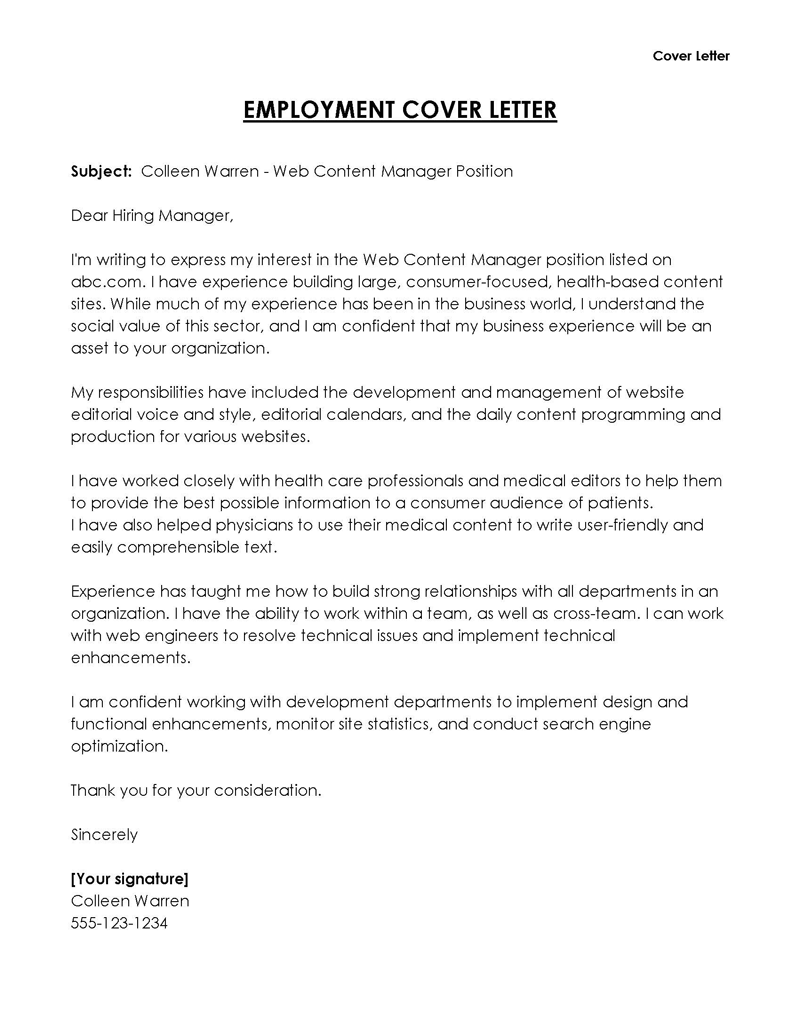
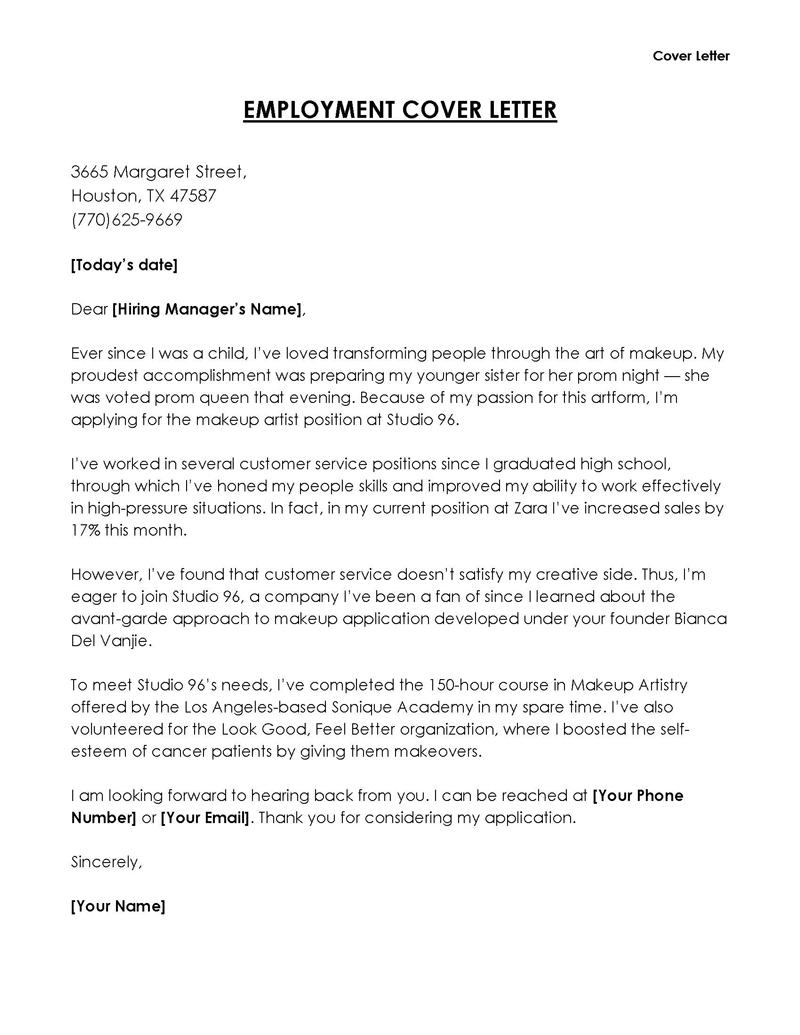
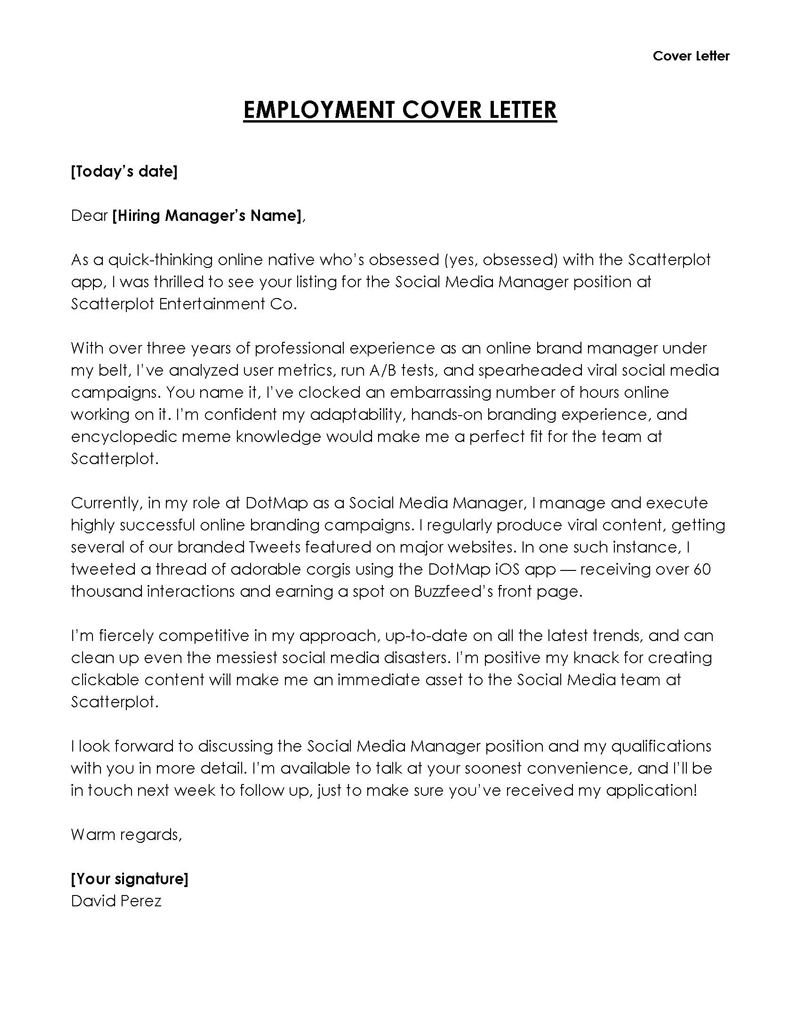
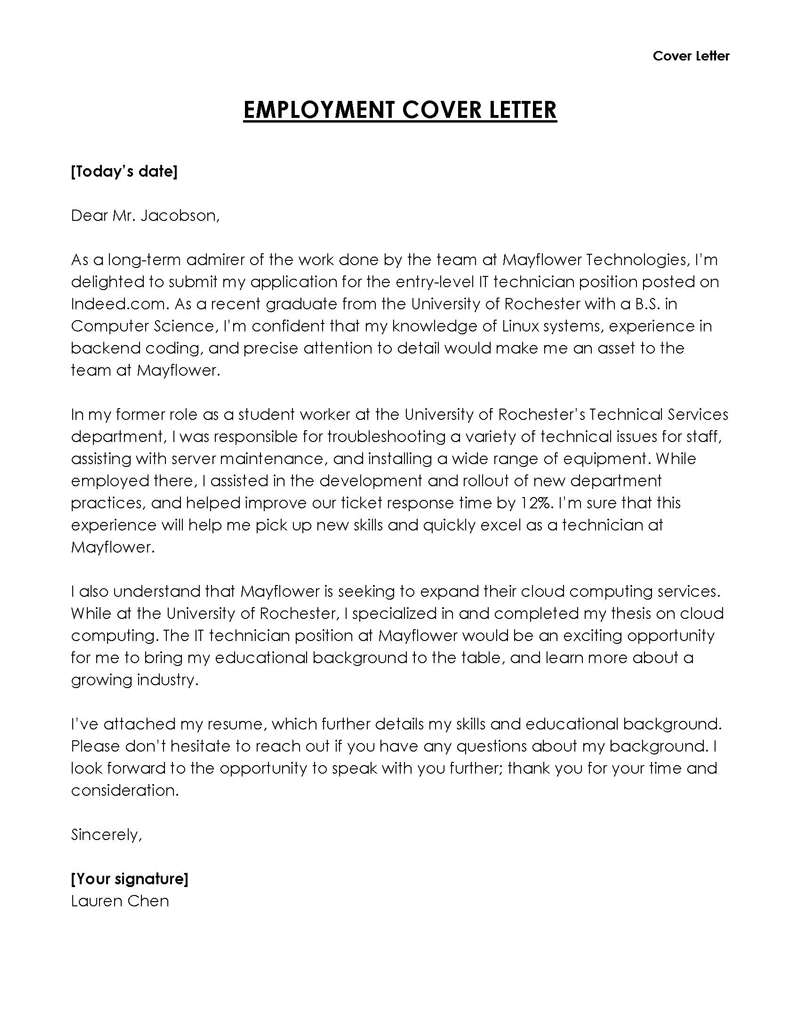
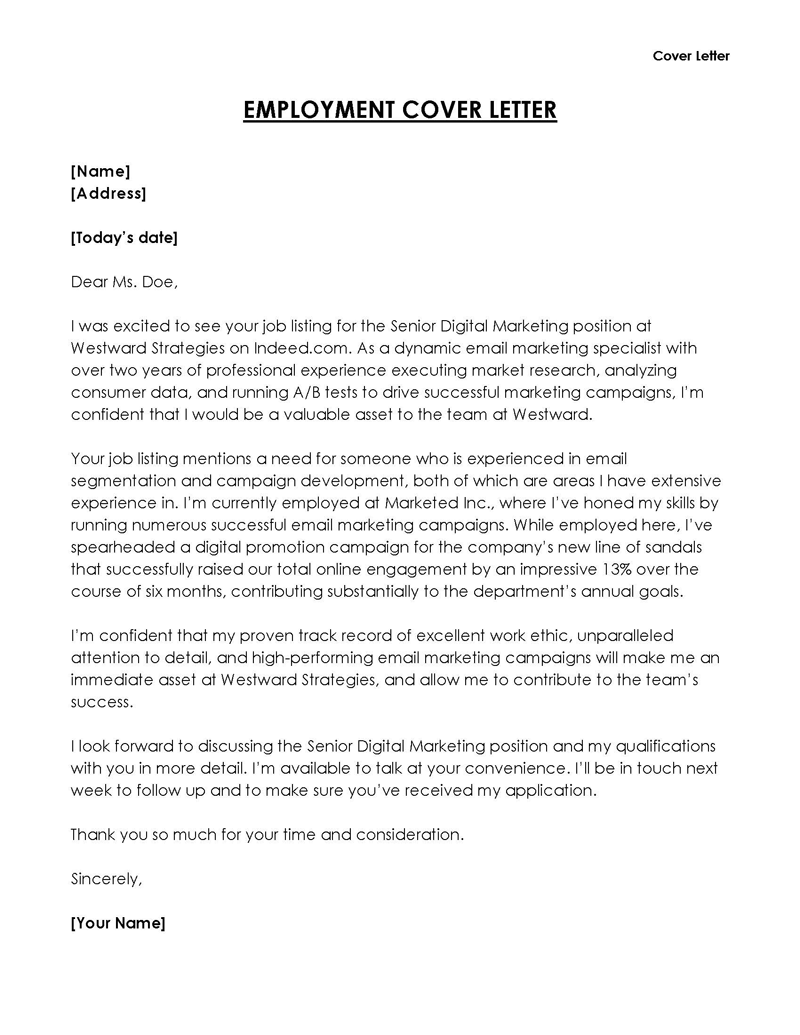
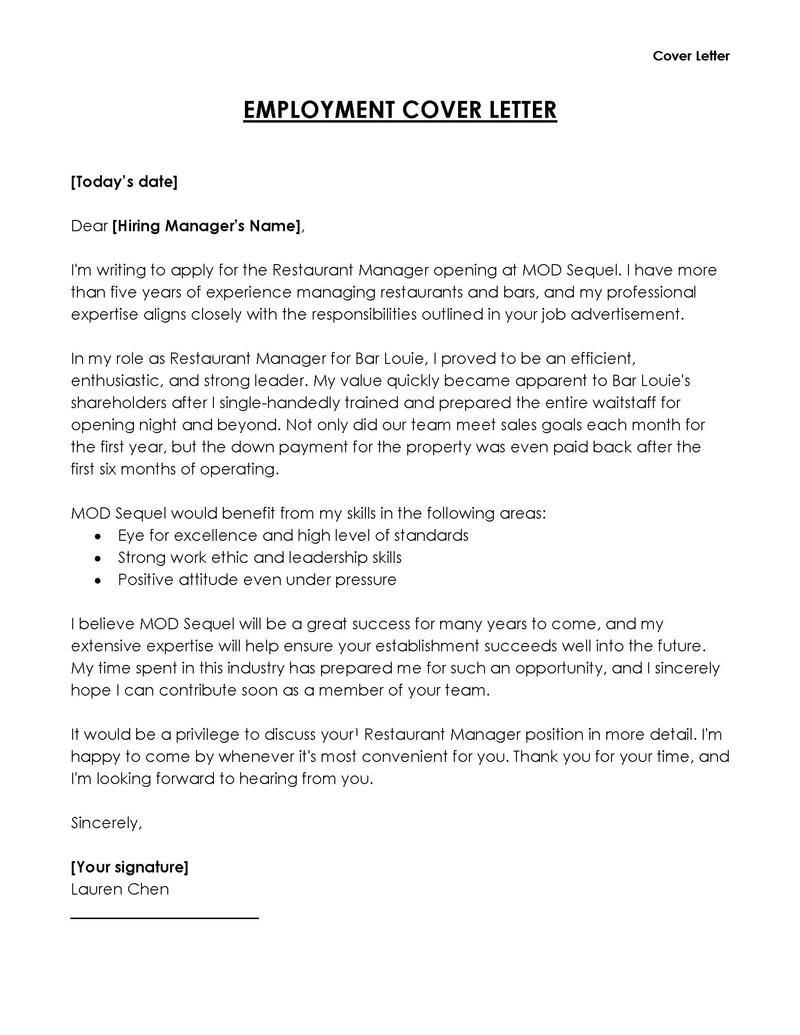
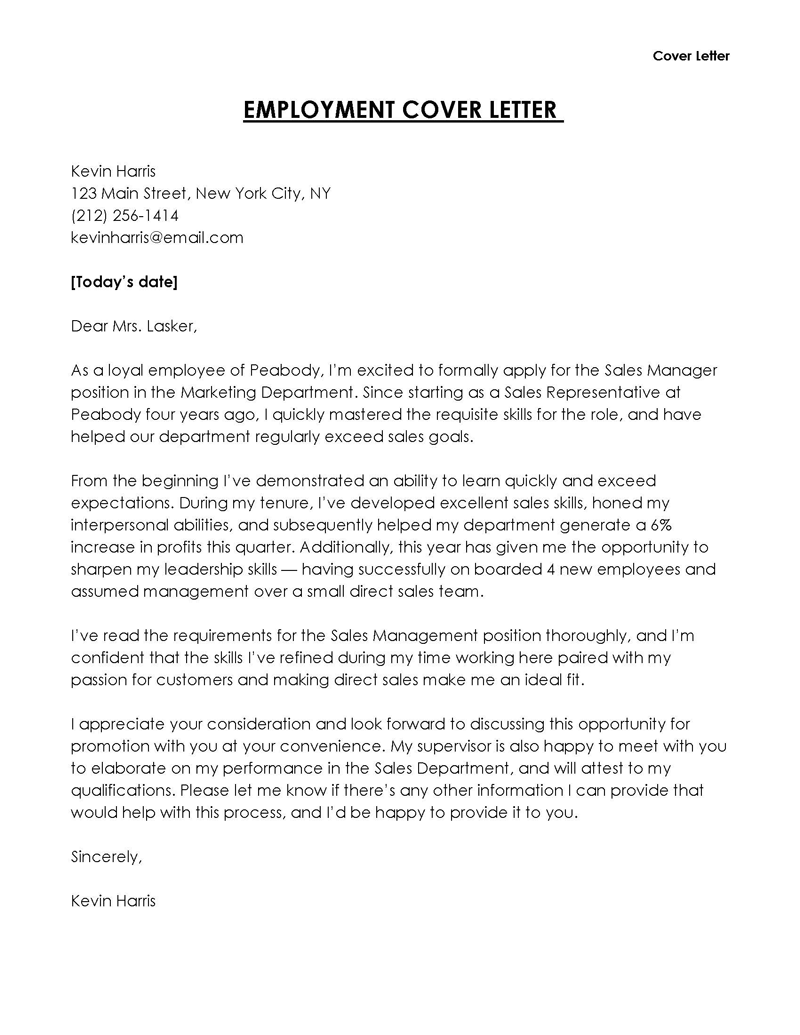
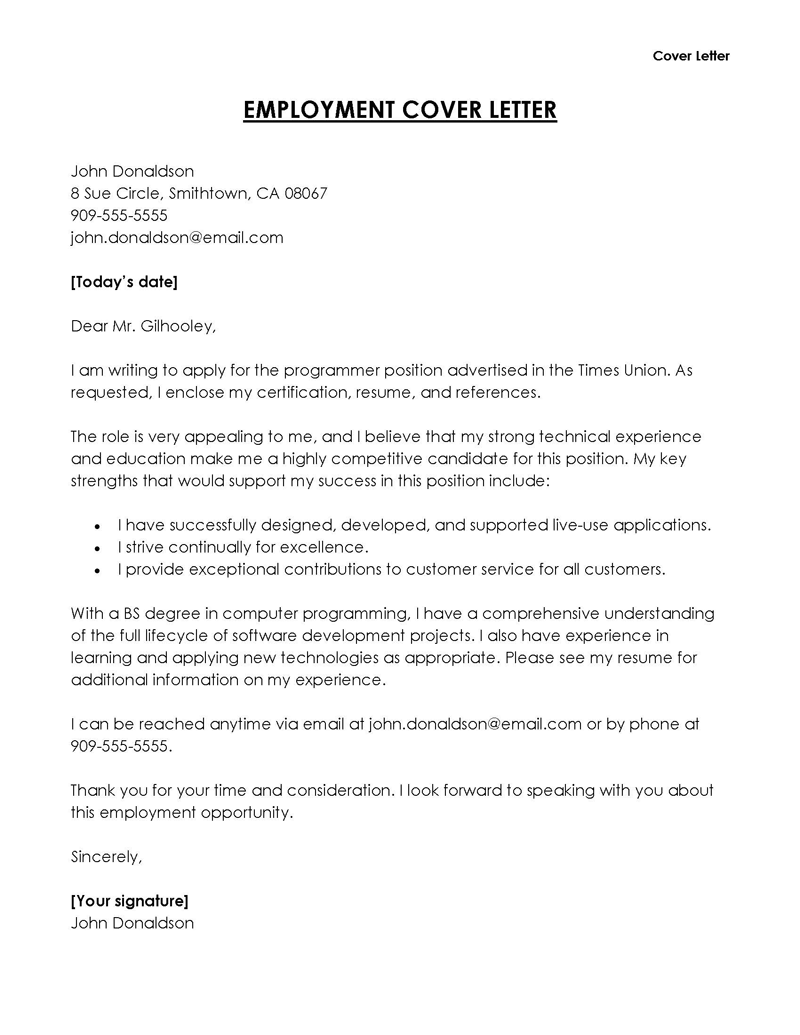
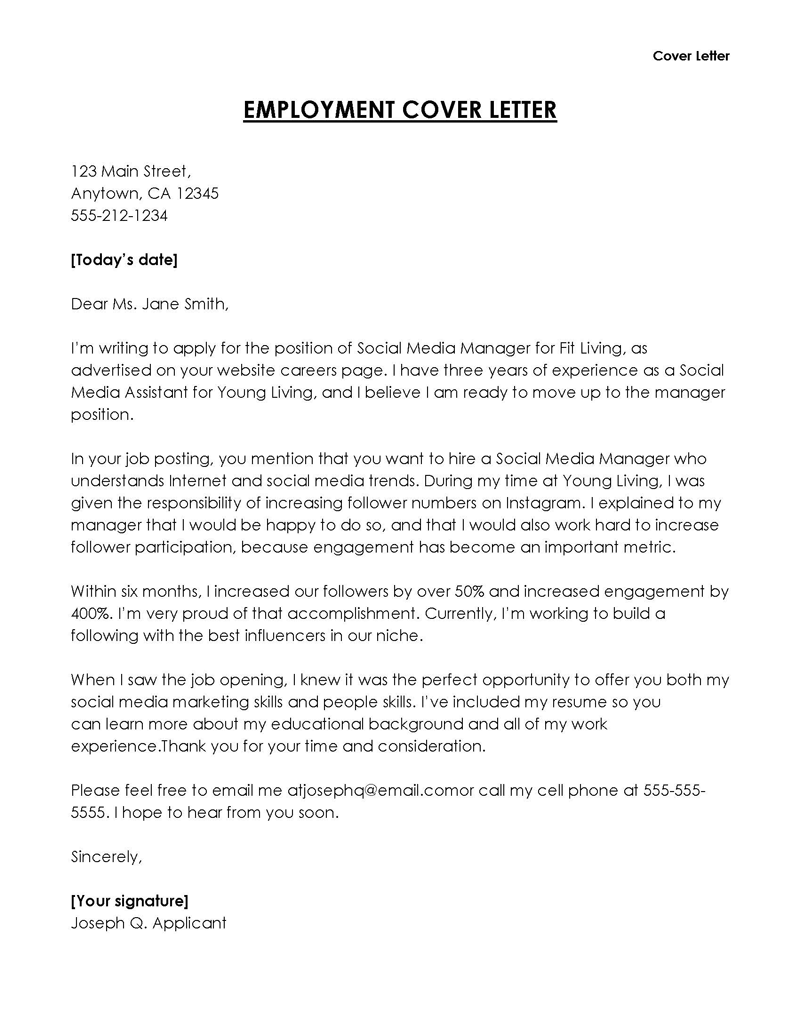
Best Practices
Some of the best practices to follow while writing an employment cover letter are as follows:
Offer something different from a resume
Use your cover letter as a supplement to your resume. You can tell a tale about your professional history and use a little more casual language than the one used on your resume. It is unusual to submit your letter by itself rather than with a resume. As a result, your letter will offer something different by highlighting information that your resume does not.
Tailor each cover letter
This letter should be designed for the position you’re applying for and should explain how your skills align with those required by the job offer. An excellent way to tailor your letter to the role is to use keywords from the job description.
Use keywords
Make use of keywords. First, note the crucial phrases in the job description, such as specific skills or prerequisites. Then, consider including some of these words in your letter. This will allow the firm to quickly decide whether you satisfy the requirements for employment.
Edit your cover letter meticulously
Proofread your letter carefully. Make sure your cover letter is impeccable. It is your first and best chance to convince the hiring manager that you are the best applicant for the job. As you review your letter, be sure there are no grammatical or typographical errors. If you want a second set of eyes, ask a friend, family member, or career counselor to read it.
Key Takeaways
- You must create a 3–4 paragraph structure before you start writing. This way, you will likely avoid missing any crucial information that can make you eligible for the job.
- Your cover letter shouldn’t be more than a page document or 250- 400 words.
- Only a strong opening paragraph will make your employer read your letter. Work on one.
- You must avoid restating what is in your resume. They both have unique roles to play in your job application.
- Your motivation for applying for the job should be clearly stated so that the hiring manager will consider you a passionate candidate.
- Be truthful and free of unnecessary details in your writing.
- Proofread your letter to ensure you are not sending a bluff letter.












